Pulsed power is a technology that consists in accumulating energy over some period of time, then releasing it very quickly. Since power equals energy (or work) divided by time, the idea is to emit a constant amount of energy in as short a time as possible. It will only last for a fraction of a second though, but that instantaneous power has very interesting applications. With this technology, power levels of more than 300 terawatts have been obtained. Is this technology for unlimited budgets, or is this in reach of the common hacker?
Consider for example discharging a capacitor. A large 450 V, 3300 uF electrolytic capacitor discharges in about 0.1 seconds (varies a lot depending on capacitor design). Since the energy stored in it is given by 1/2 CV², which gives 334 Joules of energy, the power delivered will be 3340 watts. In fact a popular hacker project is to build large capacitor banks. Once you have the bank, and a way to charge it, you can use it to power very interesting devices such as:
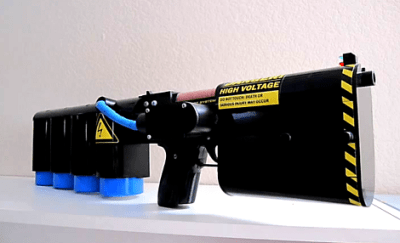
- Coilguns
- Railguns
- Washer launchers
- Coin shrinking
- Electromagnetic pulse generators
- Spot welding
- Airgap flash high speed photography
- or just to explode things out
Railguns in particular are subject to serious research. You may have read about the navy railgun, capable of reaching a muzzle speed of more than 4,600 mph (around Mach 6), more than any other explosive-powered gun. Power is provided by a 9-megajoule capacitor bank. The capacitors discharge on two conducting rails, generating an electromagnetic field that fires the projectile along the rails. The rail wear due to the tremendous pressures and currents, in the millions of amperes range, is still a problem to be solved.
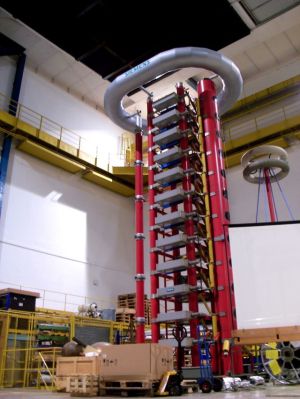
Another device that uses capacitors for high power pulses is the Marx generator. It is a very simple circuit that allows you to charge a number of capacitors in parallel and then suddenly discharge them in series using spark gaps. Very large Marx generators have been built, for high voltage component testing and other purposes, but it’s also very easy to make a small lightning simulator in under an hour if you have some high voltage capacitors and resistors. Marx generators are in use in the Z machine, a Sandia National Labs project for fusion research, that is capable of shooting 26 million amperes in 95 nanoseconds. Temperatures of 3.7 billion kelvins have been obtained.
The Marx generator is a particular case of a pulse forming network, or PFN. Capacitors, inductors and transmission lines, or a combination of them are used for energy storage in various topologies. Then, the network is discharged into the load via a high voltage switch
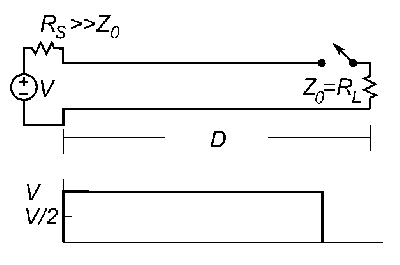
such as a spark gap or a thyratron. The transmission line PFN is interesting because the capacitance of the conductors in the line is used for both transmission and energy storage. When the power supply is connected it slowly charges up the capacitance of the line through RS. When the switch is closed, a voltage equal to V/2 is applied to the load, the charge stored in the line begins to discharge through the load a current of V/2Z0 and a voltage step travels up the line toward the source.
Compulsators (a portmanteau for compensated pulsed alternator) are another way of delivering high current pulses. They convert rotational energy from a flywheel directly into electrical energy. The compulsator works in a similar way as a normal alternator, but is designed with minimal inductance windings to deliver extremely high currents in very short time periods. There is little information on compulsator design and, as far as we know, no hobbyist has ever made one. You have your homework assignment.
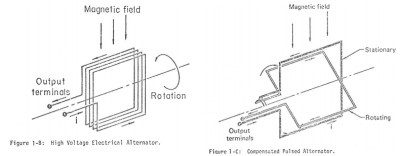
The explosively pumped flux compression generator, or EPFCG for short, is a device that generates a high power electromagnetic pulse using a high explosive to compress the magnetic flux. Million of amperes and tens of terawatts of power are produced by the EPFCG in a single pulse, since the device is destroyed in operation.

The three basic steps in flux compression are shown above.
- An external magnetic field threads a closed ring conductor.
- The ring’s diameter is reduced by the explosive. The variation of the magnetic flux induces a current in the ring, which in turn creates a new magnetic field, so that the total flux in the interior of the ring is maintained.
- The external and induced magnetic fields add up so that the total magnetic flux remains constant, and a current is created in the ring.
The compression process allows the chemical energy of the explosives to be (partially) transformed into the energy of an intense magnetic field surrounded by a correspondingly large electric current. There are several designs of EPFCG’s. The figure shows the hollow tube type.
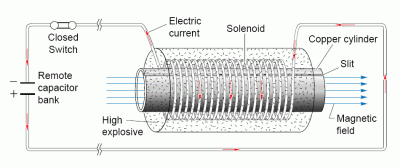
Pulsed power is also used in particle accelerators and high power lasers and the technology is rapidly evolving.
If you’re starting out, you may want to experiment with capacitor banks which are a relatively simple way of obtaining pulsed power. But if you do, take all necessary precautions. The power levels can be extremely dangerous.

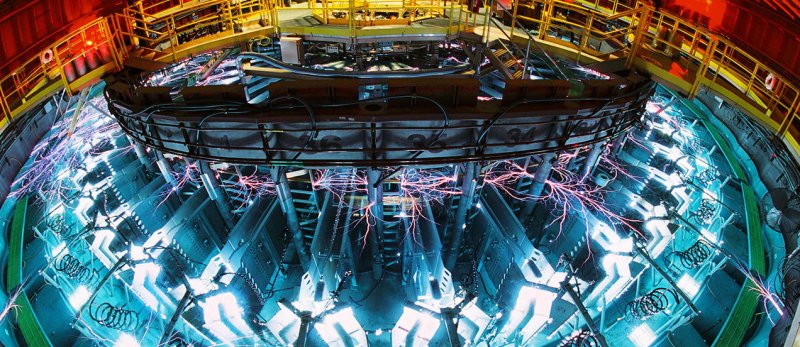















The Australian railgun program (yes, Aussies did have a railgun program with a bit of funding in the 80s) was powered by the largest homopolar generator ever made. These can generate stupidly high currents, definitely worth looking at.
The basement of the old EE building (ENS) at UT Austin used to contain a homopolar generator used to power the tokamak in the basement of the neighboring physics building (RLM). It was made from a 1920’s era power plant generator and used the mass of the rotor alone.
It was in the process of being scrapped when I attended, so I wasn’t around when it was in operation. Rumor is that the whole building would shake when it was fired.
“Rumor is that the whole building would shake when it was fired.”
Uh oh, that’s Farnsworth punch holes in the time-space continuum again. :-)
I’ve had some fun with supercaps, dumping all the energy into Nitinol wire to get it to reshape in a second or so. It’s one of those things that is unexpectedly fun.
Another pulsed energy thing I read up on a bit was the National Ignition Facility, which fuses hydrogen with 192 optically pumped lasers. Neat stuff.
I’ve got a question about mercury relays posted to the .IO stack about this.
Specifically, I want to make a wire vaporizer and was wondering if a mercury relay is the right type of switch to use (or whether it would explode).
If anyone here has experience in high-energy pulses and could advise me, I’d appreciate any insight.
https://hackaday.io/page/2643-will-a-mercury-relay-blow-up
I would not use a mercury relay. If that relay blows up, you’ll have a big mess on hand. It is not even a good switch. Too expensive and too slow. Also too much inductance. I’d use an SCR, a triggered spark gap, or make my own switch. You can layer Cu films with kapton inbetween, and then drive a tack through the stack. That will be extremely fast and give the lowest possible inductance. For the triggered spark gap, you can experiment with overvoltage protectors.
LOL SCR, you can’t even source them for a decent size electric vehicle, never mind real high energy.
An SCR or thyristor is used extensively in pulsed power.
Do a Google search on thyristor pulsed power. Commercial switches can operate north of 50 kA. They do have rate of rise issues for current so they are not good for sub microsecond pulses. IGBT’s are much better for electric vehicles because you can turn them off.
Go ahead, try to order one.
Clarification, not saying they don’t exist, just they are unavailable to non-commercial customers in single unit and small quantities, without signing a contract for x amount of product plus promise that you’re not going to build a nuke bomb trigger or other weaponised use.
Best source for the experimenter of high power capable thyristors, triacs, trigatrons etc, is surplus and surplus equipment.
https://www.excelitas.com/product-category/initiator-firing-switches
OVPs are not really a _triggered_ spark gap. Once I have seen a design, perhaps in a marx generator. There were several spark gaps made with semi-spherical electrodes, I think with something of 5 to 10cm diameter. The lowest was a “triggered” one. In the middle of the lowest potential electrode an automotive spark plug was mounted. Firing the spark plug with an ordinary ignition coil triggered the sparkgap and that triggered the other gaps, probably by a combination of overvoltage pulse and UV radiation.
did you have any more info or links on making switches with CU and Kapton? Tried some google searches and could find much information. This has me real interested for next project
I realize my comment is a few years late, but oh well. I’m sure someone will read it and benefit from it. I have been playing around with very large high voltage capacitors for a couple of decades, and one of the experiments that I never get tired of is “exploding wires”. That’s where you dump the charge from a 130uF – 4KV oil-filled pulse capacitor into a very fine wire. The wire explodes like a gun shot. It’s VERY loud. I trigger the discharge with a homemade triggered spark gap. The main gap is made with two 0.25 inch diameter Tungsten rods, and the spark initiator is just a small pointed copper rod. If you don’t care about precise timing, you can get by with simply a standard (non triggered) spark gap that will trigger when the voltage becomes high enough to jump the gap and complete the circuit to the load. It goes without saying that this kind of hobby can cause great bodily harm or death to the foolish or careless experimenter. So, BE CAREFUL!
I have not seen that footage of the navy railgun tests before. Incredible! The projectile is fishtailing which I think would be horrible for long-range accuracy. I wonder if they have figured out a method of rifling the rails (like a double helix?) to add rotation. Perhaps at these speeds it’s impossible. Maybe the projectile needs to be spun up before launching?
Also, my favorite capacitor bank discharge application is still Krux’s hard drive platter launcher.
While I recall reading that the problem has since been mitigated, I could not find the article referencing it. Regardless, the problem is not as awful as one may think. The MDA (Missile Defense Agency) partnered with the Navy on rail gun development for the purpose of developing Rail Gun based ABM systems. These are designed to intercept a missile outside of the atmosphere, at apogee of the incoming missiles trajectory. There are many practical reasons for this, one of the most important is TIME. It takes a bit of time, even at rail gun/missile speeds to make it to the edge of the atmosphere, and you need to launch with enough time to meet your target there. Due to limitations of sensing equipment and accuracy of projectiles, what this means is you have to take a guess at where the missile you are tracking will be at apogee, and fire your Kinetic Kill Vehicles/Slugs in anticipation. The inherent error in tracking estimation means that you have to have terminal guidance on board your KKV to make the final intercept course correction. For the MDA rail gun, as I understand it, they placed small explosive charges and a control circuit in the slug which would be used to make terminal course corrections for the KKV. Don’t ask me how you get an explosive and any sort of circuit to survive being fired from a rail gun, I have no idea, and my guess is its Classified. Anyway, all of that is to say that, even if it is fishtailing, its not a big problem because they only need approximate accuracy for the MDA application, and rifling would probably cause more problems because you want to time your course corrections perfectly, which I imagine would be much more difficult if your directional charges keep changing relative orientation to the flight path.
On the other hand, if you want to hit a target in atmosphere, like another ship, you would probably be better to use an APFSDS projectile and rely on a really good computer to work out the firing solution.
They been doing radar fuses on artillery since WWII so think the electronics problem well known. Basically, you just want it reeeeeeeallllly well potted.
And this was done with “hollow state” electronics (tubes)! And at least in one system with a battery activated by the centrifugal force of the spinning shell which squeezed the acid between the plates. Nice way of arming it to prevent any premature detonation.
Regarding rifling and spin: I don’t think they would do this. Even the high speed armor piercing kinetic projectiles shot with conventional chemical propellant are fin stabilized. And I am sure this would be more easy in this case. Probably the wear of the rails is more than enough even without the projectile spinning like mad.
It’s not so much a problem for the guidance system. AFAIK some missiles exist, which have a control vane which can only move in one axis. But this shell is spinning and the actuator is fast enough to move the vane when it’s looking in the right direction.
That isn’t the projectile, it is a solid sabot just for testing, here is a better video of the other team’s gun firing.
https://www.youtube.com/watch?v=NEmgSpJK9qQ
I suspect rifling will not be possible, certainly not in the near future.
Rail erosion & rail warping hasn’t been sufficiently solved with straight rails adding rifling to them will likely only compound these problems.
Sure! So probably some fin stabilization is the way to go.
That projectile is not designed to be aerodynamically stable (at least not at supersonic flight)…
If you do a bit of searching, there was slow-mo footage of a test shot with an aerodynamically correct projectile.
Whilst rifling probably isn’t viable, I wonder if you couldn’t use magnetic fields to impart a spin? Since they’d be perpendicular to the direction of the accelerating fields it shouldn’t slow down the projectile much. You could also use such fields for micoadjustments to aiming (such as counteracting vibrations on the rail).
It seems using magnetic fields, as those that we have in coil guns, are not that much capable of converting electrical energy into kinetic one, especially in comparison to the rail gun.
https://www.youtube.com/watch?v=xgxHbj-kqhs
https://en.wikipedia.org/wiki/Helical_railgun
“[Helical railguns] do not currently exist in a practical, usable form.”, but “A helical railgun was built at MIT in 1980[. …] It was able to launch a glider or projectile about 500 meters.”
KEMA in The Netherlands used (or still uses?) a couple of heavy fly-wheel generators that were powered up during a couple of hours to reach maximum speed. Then, they were connected to a shortcut or switch that had to be tested and a huge amount of current was produced which slowed down the generators in seconds. They were burried in concrete to prevent movement of the housing.
Very odd sound everytime they tested something. The high voltage was produced by the Marx generator.
Nice stuff, was about 15 years ago I walked there for my internship.
This technology is also used at the JET fusion energy experiment in the UK. Two ~700 Tonne flywheels are used, for energy storage, as all the power required for a pulse (~600MW) can’t all be drawn from the national grid at once. More info here: https://www.euro-fusion.org/fusion/jet-tech/jets-flywheels/
I wonder if that kind of quick release is hard on the longevity of those caps? Also wouldn’t be surprised if someone harnessed the power of a nuclear explosion. The ultimate pulse.
I’d be incredibly surprised!
Still, it seems to be about the speed of the explosion, not the overall power. Far as I remember a nuclear explosion isn’t all that fast, as explosives go. Plus there’s the problem of your hollow tube being vapourised before it gets a chance to shrink.
Still, would be great as a way of launching stuff into space, a railgun powered by a nuke-pumped flux compression generator. Your payload would probably vapourise too.
All I could think when I read “nuke-pumped” was this:
https://en.wikipedia.org/wiki/Project_Orion_(nuclear_propulsion)
It would technically be a form of pulsed power.
If you have a nuclear device at hand you have probably all the EMP you want. No need for any hollow tube or flux compression generator, which is needed to turn the energy of a chemical explosive into some kind of EMP.
The Nazis wanted to make an orbital “Sun Gun”; imagine a giant mirror in space aimed at the Earth. Then add a nuclear explosion. :(
https://en.m.wikipedia.org/wiki/Sun_gun
A lot of work was done with EPFCGs in early attempts to make a pure fusion nuclear explosive, that is one that didn’t need to be initiated with a fission primer.
I wonder if the author went to texas tech or took their pulsed power short course? This looks familiar.
Blowing up the bank is fun too:
https://www.youtube.com/watch?v=oGTQagT5lOI
Isn’t there an emerging use of pulsed power in radar and lidar systems for self driving cars? At the distances involved, I’d imagine you’ll need a lot of peak transmitted power to get back a usable signal.
Also interesting to note that another use of pulsed power in automotive – CDI – is slowly fading away as EVs become more and more ready for the mass market. Ironically, it’s competition from EVs that pushed automakers to continue developing that technology in an effort to stay relevant.
For something more like what most hobbyists might want to experiment with, what about a pulsed power light source that synchronizes with a video camera to more or less eliminate motion blur? A Xenon flash comes to mind for a pulsed power light source except it doesn’t work very well at the high repetition rates required.
In case of radar, it’s not emerging, but has been in use well before WW2…only difference now is that (nearly) everything is solid-state. Back then, thyratrons were used to trigger the pulse.
Big radars have peak pulse power over 1MW.
As for the synchronized light – is incredibly difficult to get a sync. signal out of a consumer camera (or to get it in :P). Only speciallised lab stuff and DIY projects have that feature.
you can just stop the lens all the way down and use a long exposure. that way, you don’t need to sync.
Completely lost. Fantastic.
Don’t forget about electroporation which can be used for pasteurization (http://may-rubentechnologies.com/index.php?option=com_content&view=article&id=47&Itemid=113) or even for maximizing olive oil extraction yield (https://www.youtube.com/watch?v=sqCbf1OwhNk)
I was a little disappointed with the article for failing to mention inductive storage – which is very useful in some physics setups, and any serious mention of the tons of exotic switches – from spark gaps, to inverse pinch switches, pyrotechnic exploding links (for inductive storage). While I haven’ done anything at large as the Z machine pictured, I have done physics where 6 kJ was discharged in way under a uS…
The switch is the hard, and therefore interesting part…Always the crucial and usually limiting factor in pulsed power.
Makes me wonder what would happen if you shot a big magnet through the center of a coil at ballistic speeds. Or a stupidly huge speaker magnet over a coil and just dropped it.
“…capable of reaching a muzzle speed of more than 4,600 mph (around Mach 6), more than any other explosive-powered gun”
Light-gas guns are explosive powered and some have a muzzle velocity that’s higher than that.
https://en.wikipedia.org/wiki/Light-gas_gun
https://fermi.gsfc.nasa.gov/acd/images/djt/hypervelocity_test.html